基于红外光谱的不同农作物秸秆磨木木质素差异表征
杨增玲,梅佳琪,曹 聪,纪冠亚,韩鲁佳
基于红外光谱的不同农作物秸秆磨木木质素差异表征
杨增玲,梅佳琪,曹 聪,纪冠亚,韩鲁佳※
(中国农业大学工学院,北京 100083)
木质素是植物细胞壁中主要组分之一,其苯丙烷结构单元的单体结构和连接方式的复杂性直接影响木质素脱除和利用效果,了解不同农作物秸秆中木质素的差异,对提高秸秆的综合利用效率是非常必要的。该文选取代表性棉秆、玉米秸和小麦秆,分别提取磨木木质素,利用傅里叶变换中红外技术对棉秆、玉米秸和小麦秆三类秸秆磨木木质素进行红外表征,分析比较三类秸秆磨木木质素的差异,结果表明:1)三类秸秆磨木木质素G/S相对比值差别不大,并无明显规律;2)三类秸秆磨木木质素中,对羟基结构单元:玉米秸>小麦秆>>棉秆;愈创木基结构单元:棉秆>玉米秸>小麦秆;紫丁香基结构单元:玉米秸>小麦秆>棉秆;3)玉米秸和小麦秆磨木木质素相似度较高,而棉秆磨木木质素则更加接近于木本植物。
秸秆;作物;光谱分析;磨木木质素;红外光谱
0 引 言
木质素作为植物细胞壁中主要组分之一,是植物细胞壁中最为复杂的天然高分子化合物之一,由苯丙烷结构单元通过醚键和碳碳键连接而成[1],含有多种活性基团。因结构单元的不同,木质素可分为3种类型:对羟基苯基丙烷单元形成的对羟基苯基木质素(hydroxy phenyl lignin,H型木质素);紫丁香基丙烷单元形成的紫丁香基木质素(syringyl lignin,S型木质素);愈创木基丙烷单元形成的愈创木基木质素(guaiacyl lignin,G型木质素)[2-3]。不同植物的木质素包含有不同的基本结构单元,如针叶木类主要是G型木质素,阔叶木类主要是S型和G型木质素,草类植物则是S型、G型和H型木质素都存在[4]。
研究表明,植物体中G型木质素单体含量越高,木质素越难脱除[5]。刘忠等[6]在乙醇法制浆过程中发现愈创木基结构单元相对紫丁香基和对羟基结构单元难于脱除。邝仕均[7]在桉木硫酸盐法制浆过程中同样也发现G/S相对比值越低的木质素越容易蒸煮和有较高的制浆得率。木质素不同单体的结构和连接还存在以下差异:愈创木基抗氧化活性要比紫丁香基强[8],且更容易进行亲电取代反应[9]和磺化[10];在臭氧处理过程中愈创木基较易降解溶出[11];木质素单体越复杂,在醇解中降解度越大,过程中产生的小分子物质会更多[12];在木质素硝化改性中,愈创木基最容易引入硝基到苯环中,最易于硝化[13];由于愈创木基结构单元易于发生缩合和偶联反应,导致在木质素的热解后残余质量会较其他高[14];在生物质固沙中,固沙材料的关联主要在木质素中的愈创木基和对羟基结构上,且对羟基结构和愈创木基结构发生交联反应的概率基本相同[15]。
从植物学角度而言,棉花、玉米和小麦3种植物同属一年生草本类被子植物;棉花属于双子叶植物,玉米和小麦属于单子叶植物[16]。三者的秸秆形态完全不同,尤以棉秆差异最大,形态很接近于木本植物。鉴于棉秆、玉米秸和小麦秆的差别所在,其利用不能一概而论。而其中差异性非常大的木质素对秸秆性质的影响不言而喻[5-7,9],了解其中木质素的差异,对于提高3类秸秆的综合利用效率是非常必要的。
木质素的分离方法通常可以分为2大类[17]:一类是将纤维素和半纤维素等成分溶解除去,将木质素作为不溶性成分沉淀下来,如盐酸木质素和硫酸木质素,该方法分离的木质素结构已发生变化;另一类是将木质素作为可溶性成分,先使用中性有机溶剂将植物中的木质素溶解,然后使其沉淀,从而将木质素分离提取出来。后者分离后的木质素得率较低,但较好地保持了木质素的化学结构,基本可以代表植物体内木质素。为了获取代表性木质素样本,分析3类秸秆木质素特性差异[18-19],本研究采用后一类方法,提取磨木木质素(milled wood lignin,MWL)用于红外光谱分析。
1 材料与方法
1.1 样品采集与制备
棉秆、玉米秸和小麦秆分别采集3个样品,取样情况如表1。
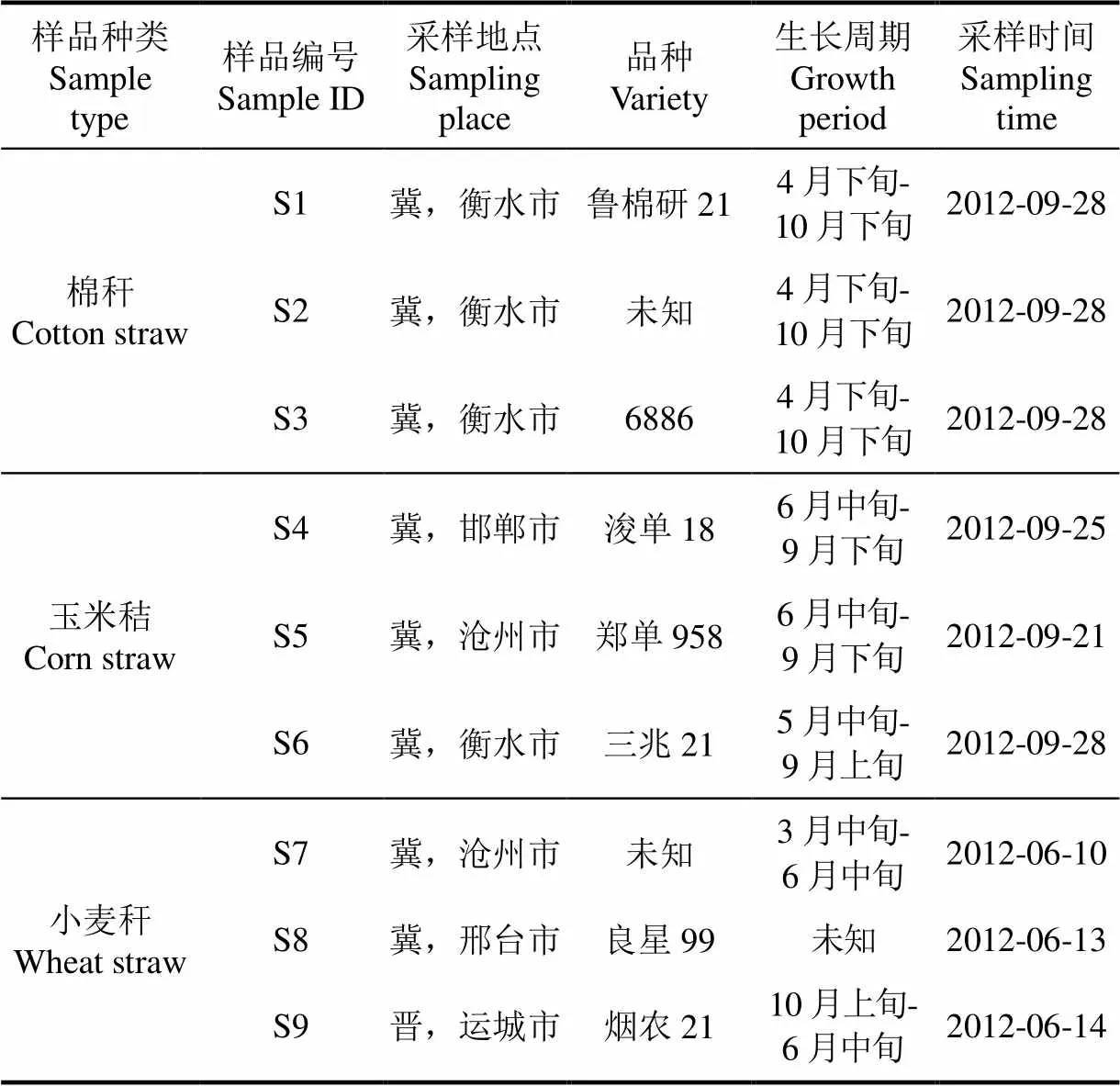
表1 棉秆、玉米秸、小麦秆采样信息表
秸秆样品粗粉过40目筛(RT-34,中国泓荃),再经苯醇溶液(体积比2 : 1)抽提12 h,抽去脂质和蜡质,在烘箱中40 ℃左右过夜烘去苯醇残余。将样品置于高能纳米球磨粉碎机(中国秦皇岛市太极环纳米制品有限公司)中,干法粉碎4 h,在粉碎过程中开启循环冷却水系统,使罐内温度保持在30 ℃以下。粉碎机使用强化不锈钢磨罐,内壁为陶瓷,磨介为氧化锆球(直径6~10 mm),球料比2 : 1。将获得的样品在45 ℃烘干3 h,封于自封样品袋中用于之后提取磨木木质素。
1.2 试验方法
1.2.1 磨木木质素(MWL)提取
本研究参考文献[20-21]提取秸秆样品的磨木木质素,具体过程如下:
1)取适量粉碎后的样品置于500 mL二氧六环:水(8 : 2)的混合溶剂中,常温下不断搅拌并重复提取3次,尽量将样品中的可溶性物质和MWL提出。
2)将提取后的混合溶液过夜沉淀,取上清液用玻璃纤维过滤,滤液用旋转蒸发仪(DV10 digital,德国IKA)在真空条件下以40 ℃温度将溶剂蒸干,便得到粗制磨木木质素。
3)将粗制磨木木质素溶解在吡啶:冰醋酸:水(9 : 1 : 4)的混合溶剂中,搅拌使其完全溶解,加入混合溶液容积10~15倍的三氯甲烷置于分液漏斗中萃取3次,留下层溶液待用。
4)将分离出的溶液用旋转蒸发仪在40 ℃真空条件下蒸发溶剂至原溶液体积的1/10左右。
5)在剩下的溶剂中加入15倍体积的乙醚,产生大量棕黄色沉淀。离心(离心机,GL-20G-C,中国上海安亭)将沉淀物与溶剂分开,将沉淀物用乙醚反复洗涤并沉淀3次。
6)将沉淀物冷冻干燥,最终得到的棕黄色粉状物即为提纯后的磨木木质素。
1.2.2 中红外光谱采集
将提取冻干后的磨木木质素取1~2 mg于玛瑙研钵中,加入约100 mg干燥的溴化钾粉末,研磨至完全混和均匀,整个过程在红外灯下进行以防止溴化钾吸水。将研磨后的粉末使用压片机在20 MPa压力下压制1 min左右,制成一定厚度和直径的透明压片。将溴化钾压片放入Spectrum 400傅里叶变换红外光谱仪(美国,PerkinElmer)中采集中红外光谱,采集参数为:光谱范围4 000~450 cm-1,扫描次数32次,光谱分辨率4 cm-1。
1.2.3 中红外光谱预处理
1 506 cm-1附近的吸收峰为苯环骨架振动吸收峰,在磨木木质素中红外吸收峰中稳定且吸收较强,通常将此峰作为参比峰。将光谱在此峰处进行归一化(A1506 = 1)后进一步分析比较秸秆样品的木质素各单体结构的含量差异[22]。
2 结果与讨论
图1为归一化后棉秆、玉米秸和小麦秆共9个样品的磨木木质素中红外光谱图;3种秸秆磨木木质素的主要峰归属[22-26]见表2。

图1 棉秆、玉米秸、小麦秆磨木木质素中红外光谱
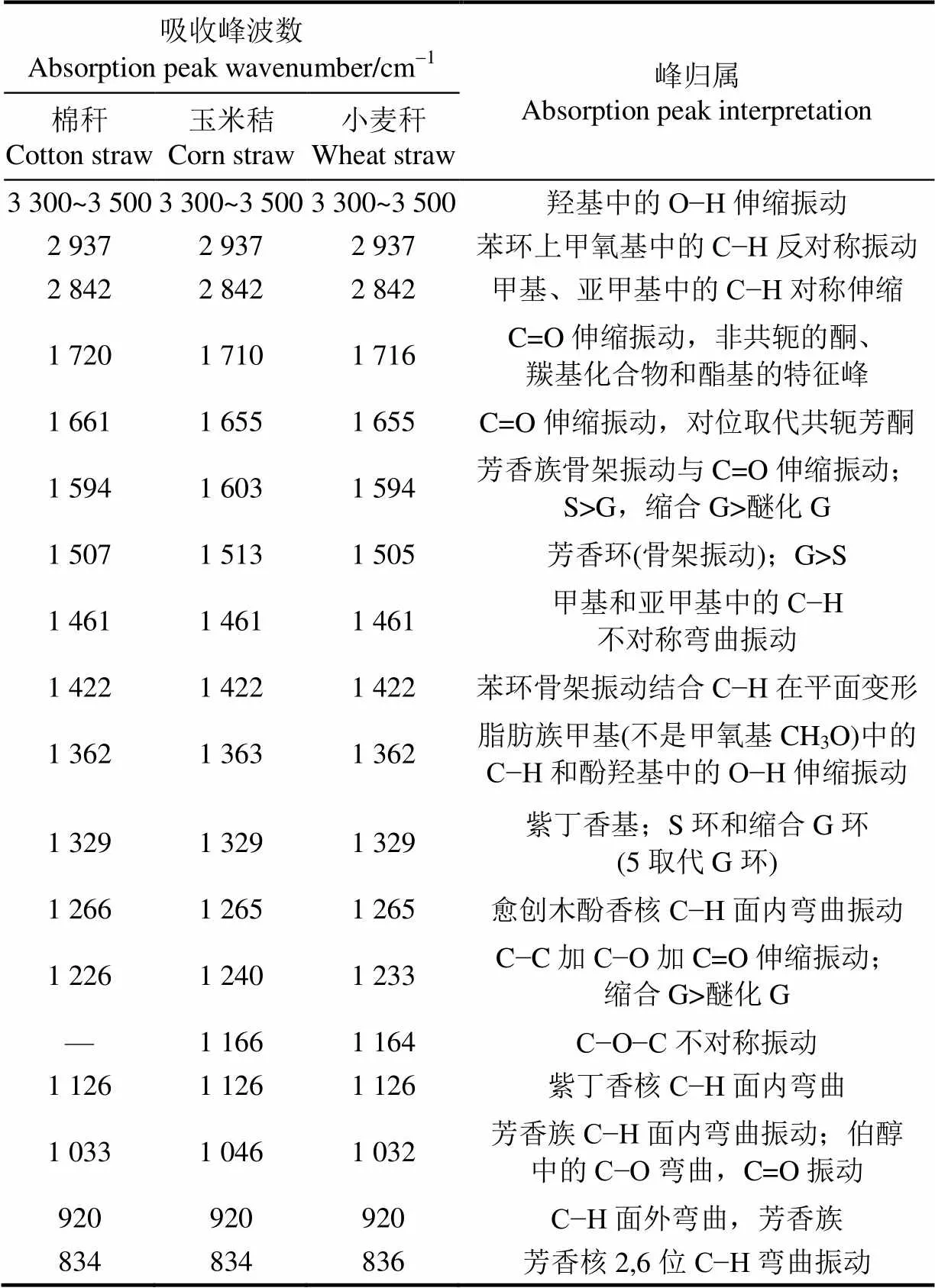
表2 棉秆、玉米秸、小麦秆木质素中红外光谱主要峰归属
由图1可以看出,不同种类秸秆样品的磨木木质素中红外光谱间存在较大的区别,同种类不同品种样品磨木木质素中红外光谱之间虽然相似度较高,但是同样也存在一定的差别。为阐述区别所在,下面从3种秸秆磨木木质素的G/S相对比值、植物学分类以及与桉木磨木木质素的比较3个方面做进一步分析。
2.1 不同秸秆磨木木质素G/S相对比值分析
1 329 cm-1附近吸收峰为木质素中紫丁香基的特征吸收,1 265 cm-1附近吸收峰为木质素中愈创木基的特征吸收,通过吸光度比值(A1265/A1329)来反映样品磨木木质素中愈创木基和紫丁香基含量的相对比值[24,27-28]。以上9个样品的G/S结果如表3,单因素方差分析结果如表4。
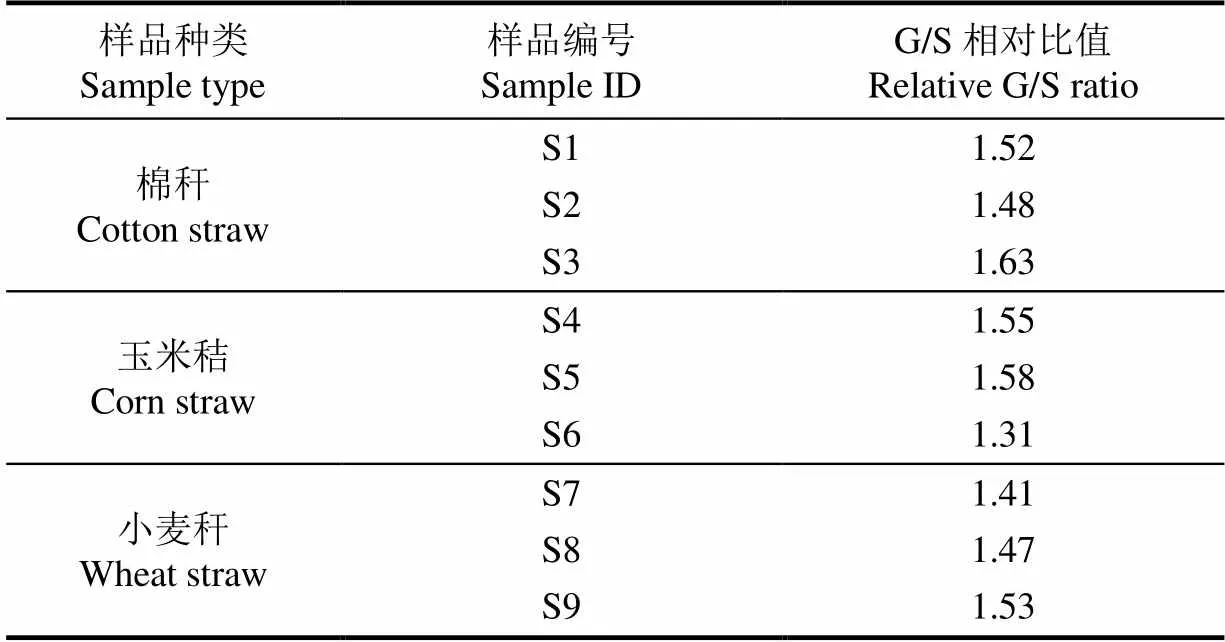
表3 棉秆、玉米秸、小麦秆G/S相对比值

表4 棉秆、玉米秸、小麦秆G/S相对比值方差分析
由表3可知,3种秸秆磨木木质素G/S相对比值均大于1,愈创木基的相对含量要比紫丁香基多。但不同的样品间比值不同,说明不同样品间G/S相对比值大小存在一定差异;而在不同种秸秆间,未出现明显的规律。棉秆、玉米秸和小麦秆的G/S相对比值表现为棉秆>玉米秸>小麦秆,但是差异较小。
由方差分析表可知,=0.656 7,即3种秸秆G/S相对比值差异不显著。
2.2 不同秸秆磨木木质素的植物分类学分析
不同植物磨木木质素的中红外谱图与其化学性质及植物分类学之间有着密切的联系。Faix[22]根据木质素中红外光谱一些特征峰的不同将木质素分为3大类:G、GS和HGS,其中GS又可细分为4小类,GS1、GS2、GS3和GS4,判别流程如图2。
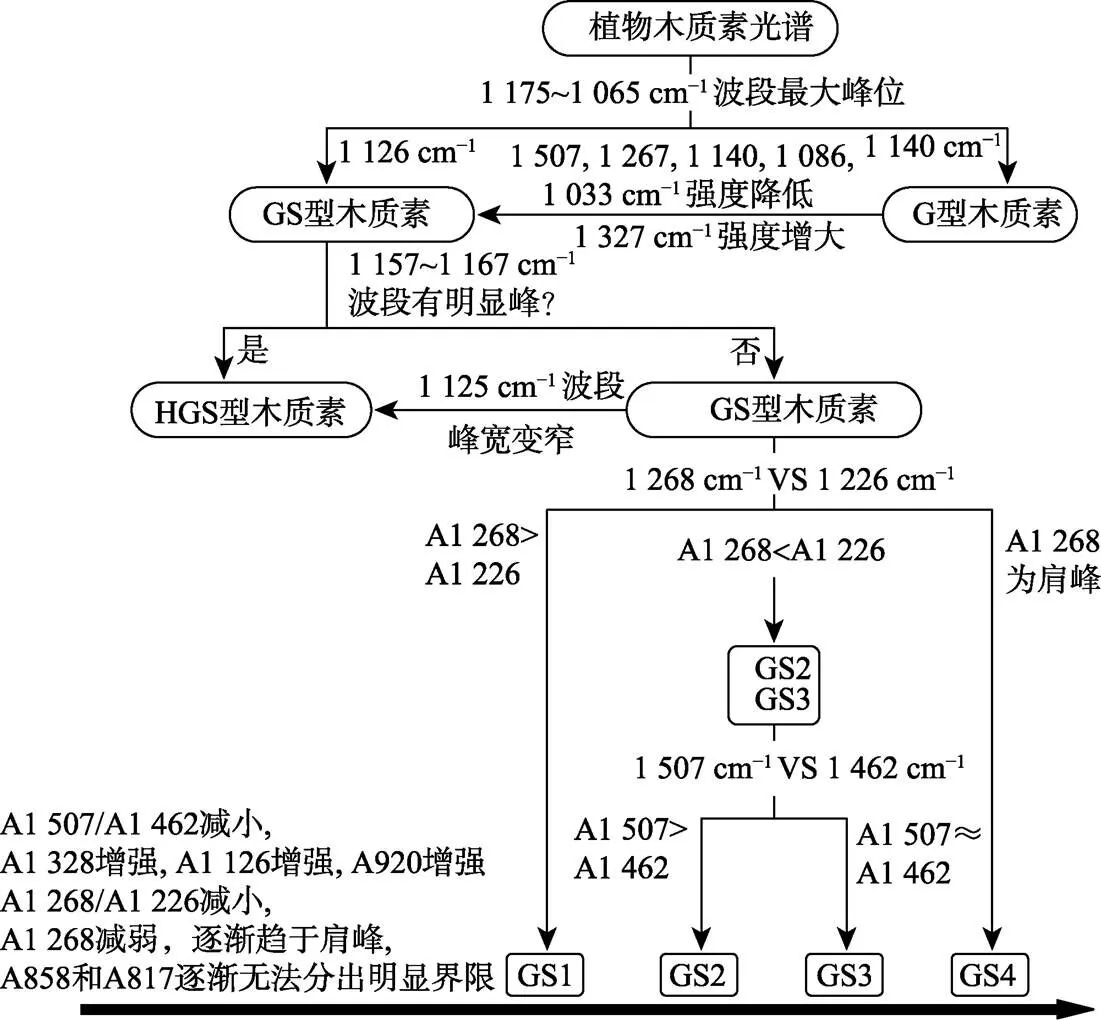
图2 木质素中红外光谱的植物分类学判别流程图
根据中红外光谱图和判别流程图,可对9个样品进行分类,具体结果如表5。由表5可知,玉米秸和小麦秆磨木木质素属于HGS类,而棉秆磨木木质素属于GS1。
图3为棉秆、玉米秸、小麦秆磨木木质素平均中红外光谱图,表6为棉秆、玉米秸、小麦秆峰强度相对值。以下结合3种秸秆磨木木质素谱图和木质素中红外主要峰归属表对3种秸秆中木质素各单体摩尔百分含量作进一步比较分析。

表5 棉秆、玉米秸、小麦秆磨木木质素植物分类学判别结果
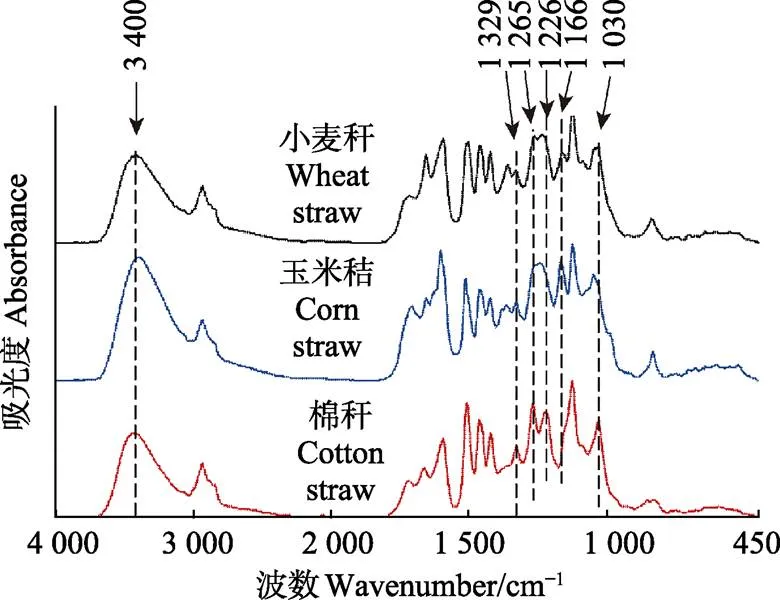
图3 棉秆、玉米秸、小麦秆磨木木质素平均红外光谱
1 166 cm-1附近为对羟基肉桂酸特征峰,即对羟基结构单元特征峰(H型木质素结构单体),在玉米秸和小麦秆磨木木质素谱图中都存在1 166 cm-1吸收峰,且该峰在玉米秸磨木木质素光谱中表现较为强烈;在棉秆磨木木质素谱图中该峰位表现为肩峰,几乎难以辨识。这说明在玉米秸磨木木质素中对羟基结构单元要多于小麦秆磨木木质素;棉秆磨木木质素中基本没有对羟基结构单元。即对羟基结构单元(H):玉米秸>小麦秆>>棉秆。
1 265 cm-1附近是愈创木基特征峰,即愈创木基结构单元特征峰(G型木质素结构单体)。玉米秸和小麦秆磨木木质素均属于HGS型木质素,谱图中都存在1 265 cm-1吸收峰,且由于C=O振动使得该吸收峰强于标准GS型木质素谱图[22-25],该峰在玉米秸磨木木质素光谱中表现略为强烈;而棉秆磨木木质素属于GS1型木质素,1265 cm-1处有着清晰可辩的吸收峰,结合表3可知棉秆磨木木质素的G/S相对比值高于玉米秸和小麦秆磨木木质素。则愈创木基结构单元(G):棉秆>玉米秸>小麦秆。
1 329 cm-1附近为紫丁香基特征峰,即紫丁香基结构单元特征峰(S型木质素结构单体)。在3种秸秆中都明显存在该峰位,峰强度相对比值:玉米秸>小麦秆>棉秆,即紫丁香基结构单元(S):玉米秸>小麦秆>棉秆。
结合Faix的预测模型[22](表7)也可大致推算3种秸秆磨木木质素中各单体的摩尔百分含量大小,对羟基结构单元(H):玉米秸≈小麦秆>棉秆;愈创木基结构单元(G):棉秆>玉米秸≈小麦秆;紫丁香基结构单元(S):棉秆≤小麦秆≈玉米秸。
前述基于峰强度相对值(A1 166,A1 329,A1 265)的相关结论,同基于Faix预测模型的结论吻合,且进一步细化了玉米秸和小麦秆磨木木质素的比较结果。

表6 棉秆、玉米秸、小麦秆峰强度相对值
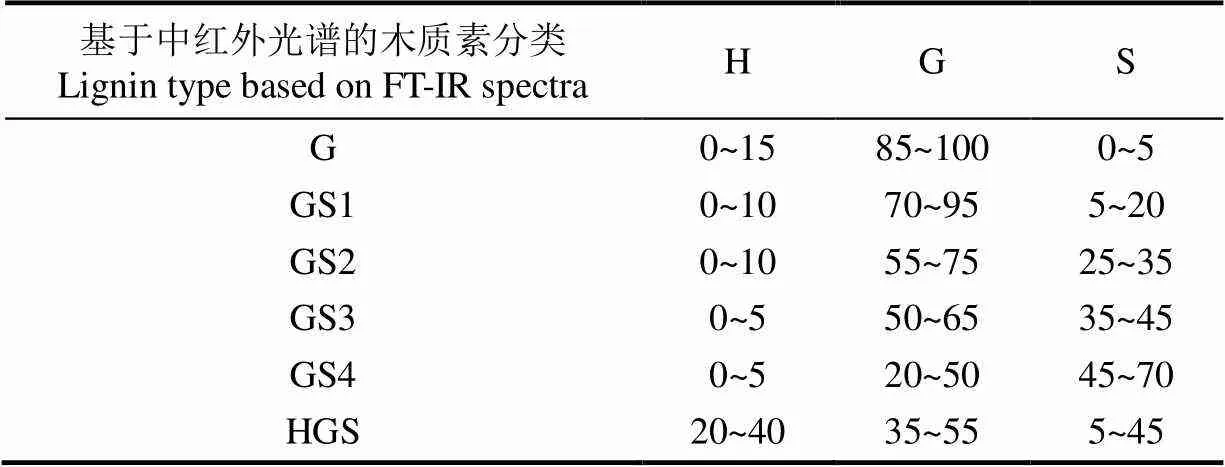
表7 基于中红外光谱分析的各类型木质素中各单体摩尔百分含量(数据引自[22])
注:H为对羟基结构单元,S为紫丁香基结构单元,G为愈创木基结构单元。
Note: H ishydroxy phenyl lignin; S is syringyl lignin; G is guaiacyl lignin.
2.3 棉秆、玉米秸、小麦秆磨木木质素与桉木磨木木质素的比较
从图3中还可以看出3种秸秆磨木木质素中含有较多的酚羟基和游离羟基官能团,表现在1 265、1 030 cm-1附近的伸缩振动以及3 400 cm-1附近宽峰的伸缩振动。在3 400 cm-1的O−H由3 600 cm-1附近发生红移,同时峰形变强变宽,证明在木质素中存在较多的羟基,形成氢键缔合作用。对比3类秸秆磨木木质素平均光谱,在峰形上小麦秆和玉米秸磨木木质素谱图比较相似,而棉秆木质素则不同,尤其表现在1 265、1 226 cm-1为2个明显区分的峰位。图4为桉木磨木木质素红外光谱[19],在1 265、1 226 cm-1也表现为2个明显区分的峰位。由此可见,在峰形上棉秆磨木木质素谱图与桉木磨木木质素更相似,可推知棉秆的木质素结构与木本植物木质素更相似。

图4 桉木磨木木质素红外光谱(图片引自[4])
(quote from Ref.4)
3 结 论
本文利用傅里叶中红外技术对棉秆、玉米秸和小麦秆3类秸秆磨木木质素进行红外表征,分析了3类秸秆磨木木质素的差异。
1)3类秸秆磨木木质素G/S相对比值差别不大,并无明显规律。
2)结合Faix预测模型和3类秸秆磨木木质素中红外谱图,3类单体含量大致如下,对羟基结构单元(H):玉米秆>小麦秆>>棉秆;愈创木基结构单元(G):棉秆>玉米秸>小麦秆;紫丁香基结构单元(S):玉米秸>小麦秆>棉秆。
3)对比棉秆、玉米秸、小麦秆磨木木质素与桉木磨木木质素中红外谱图发现,玉米秸和小麦秆磨木木质素存在一定的相似性,而棉秆磨木木质素更接近于木本植物。
[1] Li Changzhi, Zhao Xiaochen, Wang Aiqin, et al. Catalytic transformation of lignin for the production of chemicals and fuels[J]. Chem Rev, 2015, 115(21): 11559-11624. Doi: 10.1021/acs.chemrev.5b00155
[2] Gosselink R J A, Snijder M H B, Kranenbarg A, et al. Characterization and application of Nova fiber lignin[J]. Industrial Crops and Products, 2004, 20(2): 191-203. Doi: 10.1016/j.indcrop.2004.04.021
[3] 陶用珍,管映亭. 木质素的化学结构及其应用[J]. 纤维素科学与技术,2003,11(1):42-55.Tao Yongzhen, Guan Yingting. Study of chemical composition of lignin and its application[J]. Journal of Cellulose Science and Technology, 2003, 11(1): 42-45. (in Chinese with English abstract)
[4] 蒋挺大. 木质素[M]. 第2版. 北京:化学工业出版社,2009.
[5] Rencoret J, Marques G, Gutiérrez A, et al. Isolation and structural characterization of the milled-wood lignin fromwood[J]. Journal of Agricultural and Food Chemistry, 2009, 30(1): 137-143. Doi: 10.1016/j.indcrop. 2009.03.004
[6] 刘忠,齐宏升. 麦草酸催化乙醇法制浆过程中木质素结构的变化[J]. 天津科技大学学报,2008,23(2):10-13. Liu Zhong, Qi Hongsheng. Configuration transformation of lignin in wheat straw acid-catalytic ethanol pulping process [J]. Journal of Tianjin University of Science & Technology, 2008, 23(2): 10-13. (in Chinese with English abstract)
[7] 邝仕均. 桉树木材性质对其硫酸盐法制浆性能的影响[J].中国造纸,2011,30(12):51-54. Kuang Shijun. Effect of eucalyptus wood properties on its kraft pulping performance[J]. China Pulp & Paper, 2011, 30(12): 51-54. (in Chinese with English abstract)
[8] 郑秋闿,范晶晶,许凯,等. 木质素结构在聚丙烯中抗氧化作用的影响[J]. 实验室研究与探索,2013,32(6):8-11. Zheng Qiukai, Fan Jingjing, Xu Kai, et al. Effect of lignin structure on antioxidation in polypropylene[J]. Research and Exploration In Laboratory, 2013, 32(6): 8-11. (in Chinese with English abstract)
[9] 梁文学,邱学青,杨东杰,等. 麦草碱木质素的氧化和磺甲基化改性[J]. 华南理工大学学报:自然科学版,2007,35(5):117-121. Liang Wenxue, Qiu Xueqing, Yang Dongjie, et al. Modificaion of wheat straw alkali lignin by oxidation and sulfomethylation[J]. Journal of South China University of Technology: Natural Science Edition, 2007, 35(5): 117-121. (in Chinese with English abstract)
[10] 陈方,肖习蓉,陈嘉翔. 桉木化机浆制浆过程中木素结构的变化[J]. 纤维素科学与技术,1996,4(3):30-35. Chen Fang, Xiao Xirong, Chen Jiaxiang. Characterization of protolignin in Eucalyptus CMP[J]. Journal of Cellulose Science and Technology, 1996, 4(3): 30-35. (in Chinese with English abstract)
[11] 周学飞. 麦草木素在臭氧处理中的作用行为[J]. 纤维素科学与技术,2004,12(4):35-37,56. Zhou Xuefei. Behavior of wheat straw lignin during ozone treatment[J]. Journal of Cellulose Science and Technology, 2004, 12(4): 35-37, 56. (in Chinese with English abstract)
[12] 王勇,邹献武,秦特夫. 生物质醇解重质油燃烧动力学研究[J]. 林产化学与工业,2012,32(1):35-38. Wang Yong, Zou Xianwu, Qin Tefu. Combustion kinetics analysis of fuel oil derived from biomass liquefaction with 1- octanol[J]. Chemistry and Industry of Forest Products, 2012, 32(1): 35-38. (in Chinese with English abstract)
[13] 宋湛谦,Han J S,Rowell R M. 花旗松纤维和槿麻纤维的硝酸化学改性[J]. 林产化学与工业,1999,19(1):1-5. Song Zhanqian, Han J S, Rowell R M. Chemical modification of douglas fir and kenaf fibers by nitric acid[J]. Chemistry and Industry of Forest Products, 1999, 19(1): 1-5. (in Chinese with English abstract)
[14] 娄瑞,武书彬,吕高金,等. 草本类木素的化学结构与热化学性质[J]. 华南理工大学学报:自然科学版,2010,38(8):1-6. Lou Rui, Wu Shubin, Lǜ Gaojin, et al. Chemical structure and thermochemical properties of lignin from herbaceous plant[J]. Journal of South China University of Technology:Natural Science Edition, 2010, 38(8): 1-6. (in Chinese with English abstract)
[15] 金永灿,刘军,杨益琴,等. 草浆废液制备生物质固沙材料及其在植被恢复上的应用(系列报道之二)生物质固沙材料的结构特性[J]. 中华纸业,2006,27(10):75-78. Jin Yongcan, Liu Jun, Yang Yiqin, et al. Preparation of biomass sand stabilization material from straw pulp effluent and its application on vegetation restoration (II): Structural characteristics of biomass sand stabilization material[J]. China Pulp & Paper Industry, 2006, 27(10): 75-78. (in Chinese with English abstract)
[16] 徐汉卿等主编. 植物学[M]. 北京:北京农业大学出版社, 1994.
[17] 李忠正. 可再生生物质资源——木质素的研究[J]. 南京林业大学学报:自然科学版,2012,36(1):1-7. Li Zhongzheng. Research on renewable biomass resource: Lignin[J]. Journal of Nanjing Forestry University: Natural Science Edition, 2012, 36(1): 1-7. (in Chinese with English abstract)
[18] John Ralph, GöstaBrunow, Philip J Harris, et al. Lignification: Are lignins biosynthesized via simple combinatorial chemistry or via proteinaceous control and template replication?[J]. Recent Advances in Polyphenol Research, 2008, 1: 36-66. Doi: 10.1002/9781444302400.ch2
[19] Priscila Maziero, Mario de Oliveira Neto, Douglas Machado, et al. Structural features of lignin obtained at different alkaline oxidation conditions from sugarcane bagasse[J]. Industrial Crops and Products, 2012, 35(1): 61-69. Doi: 10.1016/j. indcrop.2011.06.008
[20] Brownell H H. Isolation of milled lignin and lignin carbohydrate complex[J]. TAPPI, 1965, 48: 513-518.
[21] Anderson Guerra, Ilari Filpponen, Lucian A Lucia, et al. Comparative evaluation of three lignin isolation protocols for various wood species[J]. Journal of Agricultural and Food Chemistry, 2006, 54(26): 9696-9705. Doi: 10.1021/jf062433c
[22] Faix O. Classification of lignins from different botanical origins by FT-IR spectroscopy[J]. Holzforschung, 1991, 45(Supp.1): 21-28. Doi: 10.1515/hfsg.1991.45.s1.21
[23] Rumana Rana, Rosemarie Langenfeld-Heyser, Reiner Finkeldey, et al. FTIR spectroscopy, chemical and histochemical characterisation of wood and lignin of five tropical timber wood species of the family of Dipterocarpaceae[J]. Wood Science and Technology, 2009, 44(2): 225-242. Doi: 10.1007/s00226-009-0281-2
[24] 陈方,陈嘉翔. 桉木木素的付立叶变换红外光谱研究[J].纤维素科学与技术,1994,2(2):14-20. Chen Fang, Chen Jiaxiang. FTIR study of lignin from Eucalyptus[J]. Journal of Cellulose Science and Technology, 1994, 2(2): 14-20. (in Chinese with English abstract)
[25] 邸明伟. 生物质材料现代分析技术[M]. 北京:化学工业出版社,2010.
[26] Sun R, Sun X F, Wang S Q, et al. Ester and ether linkages between hydroxycinnamic acids and lignins from wheat, rice, rye, and barley straws, maize stems, and fast-growing poplar wood[J]. Industrial Crops and Products, 2002, 15(3): 179-188. Doi: 10.1016/S0926-6690(01)00112-1
[27] Li L, Zhou Y, Cheng X, et al. Combinatorial modification of multiple lignin traits in trees through multigene cotransformation [J]. Proceedings of the National Academy of Science of the United States of America, 2003, 100(8): 4939-4944. Doi: 10.1073/pnas.0831166100
[28] Antonovic A, Jambrekovic V, Franjic J, et al. Influence of sampling location on content and chemical composition of the beech native lignin ()[J]. Periodicum Biologorum, 2010, 112(3), 327-332.
Traits of milled wood lignin isolated from different crop straw based on FT-IR
Yang Zengling, Mei Jiaqi, Cao Cong, Ji Guanya, Han Lujia※
(,100083,)
As vast agricultural byproduct and an important source of lignocellulosic biomass in China, straws of maize, cotton and wheat are now being developed as renewable energy resources to address a serious energy shortage and environmental issues related to other energy sources. It is necessary to improve the comprehensive utilization efficiency of the three types of straw. Although maize (monocotyledon), cotton (dicotyledon) and wheat (monocotyledon) belong to therophyte herbage from the perspective of phytology, but their straw forms are totally different. For the sake of the difference among them, the utilization cannot be generalized without regard to the effect of chemical composition, in particular the characteristics of lignin. It is composed of phenyl propane monomers connected by the ether and carbon-carbon bonds, containing a variety of active groups. There are three types of phenylpropane, p-hydroxy phenyl, guaiacyl and syringyl, which correspond to hydroxy phenyl lignin (H-lignin), syringyl lignin (S-lignin) and guaiacyl lignin (G-lignin), respectively. Lignin within plants has different shares of the three constitutional units. The heterogeneity of linkage types among the phenyl propane monomers has different effects on the pretreatment for the utilization and removal of lignin. Previous researches have shown that the relative ratio of G-lignin/S-lignin (G/S value) is relevant to the ease or complexity of delignification. Therefore, the higher the ratio, the harder the delignification is. In this paper, three samples of each kind of straw were collected, coarse grinded, degreased, dewaxed, and fine grinded, in sequence. Then the milled wood lignin (MWL) was isolated from the straws of cotton, corn and wheat. After the all procedures above, MWL was studied with FT-IR, by potassium bromide pellet technique. Normalization was conducted with 9 spectra obtained, at the wavelength of 1 506 cm-1(to make A1 506=1) as spectral pretreatment. Then the spectra were compared in 3 aspects: the relative G/S ratio represented by A1 265/A1 329, the identification of lignin types based on plant taxonomy, and the differences and similarities comparing with the MWL from eucalyptus. The results indicate that there is more guaiacyl and less syringyl in the MWL isolated from the samples, the relative ratio of G/S among the three kinds of straws was not significant difference, and no evident regularity is found. Secondly, the identification results based on plant taxonomy show that the MWL from cotton straw is the type of GS1, while that from corn and wheat straw belong to the type of HGS; the content of basic units of lignin in mole percent in these straws have following laws: for H-lignin, corn straw>wheat straw>>cotton straw; for G-lignin, cotton straw>corn straw>wheat straw; for S-lignin, corn straw>wheat straw>cotton straw. Thirdly, the MWL isolated from straw of corn and wheat share the generality of gramineous plants, while the MWL from cotton straw is closer to ligneous plants, which have distinguish peak at 1 265 and 1 226 cm-1.
straw;crops; spectrum analysis; milled wood lignin; FT-IR
10.11975/j.issn.1002-6819.2018.19.028
S216
A
1002-6819(2018)-19-0219-06
2018-04-04
2018-08-08
国家自然科学基金(31471407);教育部创新团队计划(IRT_17R105)
杨增玲,教授,博士,博士生导师,主要从事光谱技术、显微光谱技术和光谱图像技术在农业中的应用研究。Email:yangzengling@cau.edu.cn
韩鲁佳,教授,博士,博士生导师,长江学者特聘教授,主要从事农业生物质工程研究。Email:hanlj@cau.edu.cn
杨增玲,梅佳琪,曹 聪,纪冠亚,韩鲁佳. 基于红外光谱的不同农作物秸秆磨木木质素差异表征[J]. 农业工程学报,2018,34(19):219-224. doi:10.11975/j.issn.1002-6819.2018.19.028 http://www.tcsae.org
Yang Zengling, Mei Jiaqi, Cao Cong, Ji Guanya, Han Lujia. Traits of milled wood lignin isolated from different crop straw based on FT-IR[J]. Transactions of the Chinese Society of Agricultural Engineering (Transactions of the CSAE), 2018, 34(19): 219-224. (in Chinese with English abstract) doi:10.11975/j.issn.1002-6819.2018.19.028 http://www.tcsae.org

